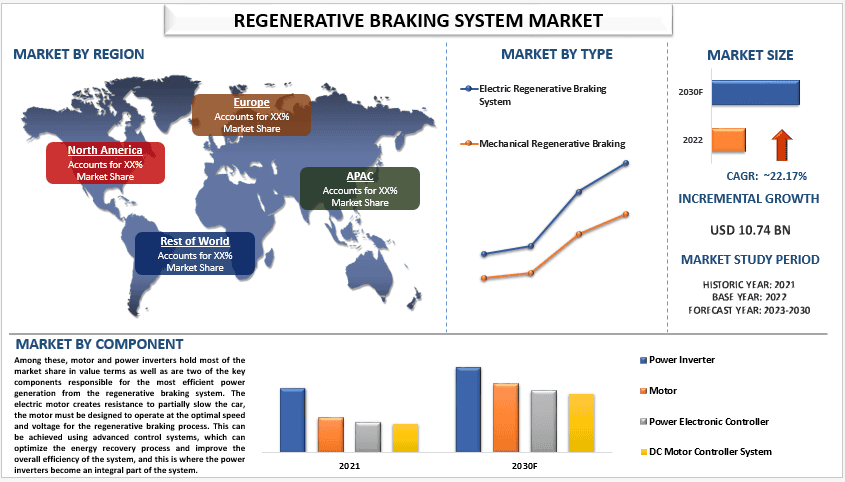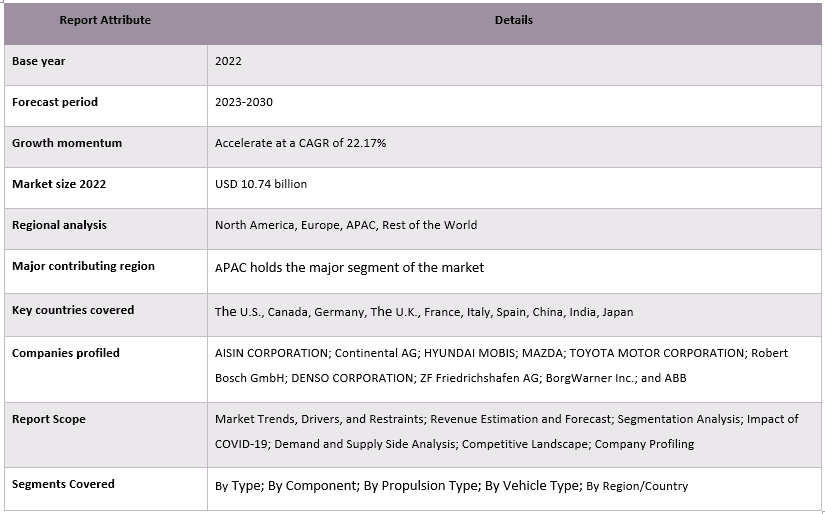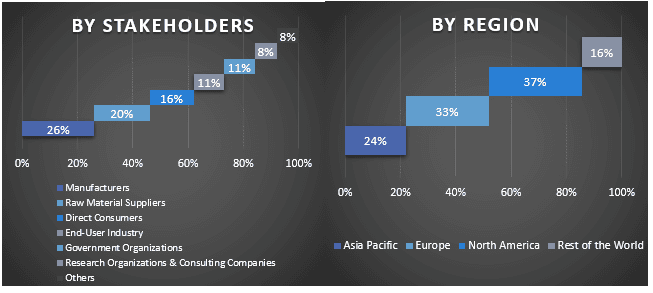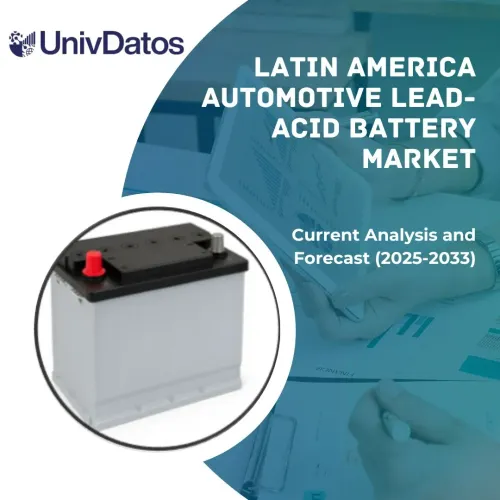- Home
- Chi siamo
- Settore
- Servizi
- Lettura
- Contattaci
Mercato dei sistemi di frenatura rigenerativa: analisi attuale e previsioni (2023-2030)
Enfasi sul tipo (Sistemi di frenata rigenerativa elettrica (ERB) e Sistemi di frenata rigenerativa meccanica (MRB)), Componente (Inverter di potenza, Motore, Controllore di elettronica di potenza e Sistema di controllo motore DC), Tipo di propulsione (BEV e HEV/PHEV), Tipo di veicolo (Autovettura, Motociclo e Veicolo commerciale) e Regione/Paese

Il mercato dei sistemi di frenatura rigenerativa è stato valutato a 10,74 miliardi nel 2022 e si prevede che crescerà a un ritmo costante di circa il 22,17% durante il periodo di previsione (2023-2030), grazie alla crescente adozione di veicoli elettrici a livello globale. Inoltre, il sistema di frenatura rigenerativa presenta diversi vantaggi rispetto ai sistemi di frenatura tradizionali. Consente un uso più efficiente dell'energia, poiché l'energia cinetica generata dai freni viene convertita in energia elettrica anziché essere persa sotto forma di calore. Consente inoltre una maggiore autonomia del veicolo, poiché l'energia elettrica immagazzinata può essere utilizzata per alimentare il motore elettrico del veicolo, estendendone l'autonomia. Inoltre, tendenze come il miglioramento della tecnologia delle batterie, la crescente attenzione alla sostenibilità, la crescente urbanizzazione e la crescente domanda di veicoli connessi e autonomi stanno ulteriormente aumentando la domanda di sistemi di frenatura rigenerativa nel mercato, con la crescente domanda di veicoli elettrici. Ad esempio, negli Stati Uniti, alla fine del 2021, circolavano circa 2 milioni di veicoli elettrici leggeri, inclusi 700.000 veicoli elettrici ibridi plug-in (PHEV).
Alcuni dei principali operatori che operano sul mercato sono AISIN CORPORATION; Continental AG; HYUNDAI MOBIS; MAZDA; TOYOTA MOTOR CORPORATION; Robert Bosch GmbH; DENSO CORPORATION; ZF Friedrichshafen AG; BorgWarner Inc.; e ABB. Diverse fusioni e acquisizioni, insieme a partnership, sono state intraprese da questi operatori per fornire ai clienti prodotti/tecnologie hi-tech e innovativi.
Approfondimenti presentati nel rapporto
"Tra i tipi, il segmento dei sistemi di frenatura rigenerativa elettrica (ERB) detiene la maggior parte della quota di mercato nel 2022."
In base al tipo, il mercato è suddiviso in sistemi di frenatura rigenerativa elettrica (ERB) e sistemi di frenatura rigenerativa meccanica (MRB). Tra questi, il sistema di frenatura rigenerativa elettrica ha un'elevata quota di mercato nel 2022 e dominerà durante il periodo di previsione. Ciò è dovuto al fatto che l'ERB è più efficiente dell'MRB perché utilizza il motore elettrico del veicolo per generare elettricità, il che è più efficiente rispetto all'utilizzo di un dispositivo meccanico. Ciò significa che l'ERB può recuperare più energia dalla frenata e ricaricare la batteria in modo più efficace. Inoltre, i sistemi ERB sono notevolmente più sicuri e affidabili del sistema MRB e quindi possono fornire un'esperienza di frenata più fluida e migliorare la sicurezza generale sulle strade.
"Tra i componenti, il segmento Inverter e motore detiene la maggior parte della quota di mercato nel 2022."
In base ai componenti, il mercato è segmentato in inverter di potenza, motore, controller di elettronica di potenza e sistema di controller motore CC. Tra questi, il motore e gli inverter di potenza detengono la maggior parte della quota di mercato in termini di valore e sono anche due dei componenti chiave responsabili della generazione di energia più efficiente dal sistema di frenatura rigenerativa. Il motore elettrico crea resistenza per rallentare parzialmente l'auto, il motore deve essere progettato per funzionare alla velocità e alla tensione ottimali per il processo di frenatura rigenerativa. Ciò può essere ottenuto utilizzando sistemi di controllo avanzati, che possono ottimizzare il processo di recupero dell'energia e migliorare l'efficienza complessiva del sistema, ed è qui che gli inverter di potenza diventano parte integrante del sistema.
RICHIESTA DI PERSONALIZZAZIONE
"La regione APAC detiene la maggior parte del periodo di mercato nel 2022."
La regione con il mercato più grande per il sistema di frenatura rigenerativa è l'APAC, dove metà dei veicoli elettrici venduti in tutto il mondo si trovava solo in Cina nel 2022. Inoltre, la crescente infrastruttura di ricarica e gli incentivi e i sussidi governativi stanno ulteriormente incrementando la domanda di veicoli elettrici nella regione APAC. Inoltre, la crescente urbanizzazione e l'accessibilità economica della popolazione in queste regioni sono anche uno dei principali fattori trainanti che spingono verso l'alto la domanda di veicoli elettrici nella regione, il che a sua volta sta aumentando anche la domanda di sistemi di frenatura rigenerativa nel mercato. Oltre a questa enorme presenza, diversi produttori nel segmento dei veicoli elettrici stanno ulteriormente spostando la domanda fornendo opzioni ai consumatori in base alle loro esigenze e desideri, con un numero enorme di lanci di prodotti a ogni fascia di prezzo e design.
Copertura del rapporto sul mercato dei sistemi di frenatura rigenerativa

Motivi per acquistare questo rapporto:
- Lo studio include l'analisi delle dimensioni del mercato e delle previsioni convalidate da esperti chiave del settore autenticati.
- Il rapporto presenta una rapida panoramica delle prestazioni complessive del settore a colpo d'occhio.
- Il rapporto copre un'analisi approfondita dei principali concorrenti del settore con un focus primario sui principali dati finanziari aziendali, portafogli di prodotti, strategie di espansione e sviluppi recenti.
- Esame dettagliato dei fattori trainanti, dei vincoli, delle tendenze chiave e delle opportunità prevalenti nel settore.
- Lo studio copre in modo completo il mercato attraverso diversi segmenti.
- Analisi approfondita a livello regionale del settore.
Opzioni di personalizzazione:
Il mercato globale dei sistemi di frenatura rigenerativa può essere ulteriormente personalizzato in base alle esigenze o a qualsiasi altro segmento di mercato. Inoltre, UMI comprende che potresti avere le tue esigenze aziendali, quindi sentiti libero di contattarci per ottenere un rapporto che si adatti completamente alle tue esigenze
Indice
Metodologia di ricerca per l'analisi del mercato dei sistemi di frenatura rigenerativa (2023-2030)
L'analisi del mercato storico, la stima del mercato attuale e la previsione del mercato futuro del mercato globale dei sistemi di frenatura rigenerativa sono stati i tre passaggi principali intrapresi per creare e analizzare l'adozione di sistemi di frenatura rigenerativa nelle principali regioni a livello globale. È stata condotta un'esaustiva ricerca secondaria per raccogliere i dati storici del mercato e stimare le dimensioni del mercato attuale. In secondo luogo, per convalidare queste intuizioni, sono state prese in considerazione numerose scoperte e ipotesi. Inoltre, sono state condotte anche esaurienti interviste primarie con esperti del settore in tutta la catena del valore del mercato globale dei sistemi di frenatura rigenerativa. Post-assunzione e convalida dei dati di mercato attraverso interviste primarie, abbiamo impiegato un approccio top-down/bottom-up per prevedere le dimensioni complete del mercato. Successivamente, sono stati adottati metodi di ripartizione del mercato e triangolazione dei dati per stimare e analizzare le dimensioni del mercato dei segmenti e sottosegmenti del settore di riferimento. La metodologia dettagliata è spiegata di seguito:
Analisi delle dimensioni storiche del mercato
Passaggio 1: Studio approfondito delle fonti secondarie:
È stato condotto uno studio secondario dettagliato per ottenere le dimensioni storiche del mercato dei sistemi di frenatura rigenerativa attraverso fonti interne all'azienda come relazioni annuali e bilanci, presentazioni di performance, comunicati stampa, ecc., e fonti esterne tra cui riviste, notizie e articoli, pubblicazioni governative, pubblicazioni della concorrenza, relazioni di settore, database di terze parti e altre pubblicazioni credibili.
Passaggio 2: Segmentazione del mercato:
Dopo aver ottenuto le dimensioni storiche del mercato dei sistemi di frenatura rigenerativa, abbiamo condotto un'analisi secondaria dettagliata per raccogliere informazioni storiche sul mercato e quote per diversi segmenti e sottosegmenti per le principali regioni. I principali segmenti inclusi nel rapporto sono tipo, componente, tipo di propulsione e tipo di veicolo. Sono state condotte ulteriori analisi a livello di paese per valutare l'adozione complessiva dei modelli di test in quella regione.
Passaggio 3: Analisi dei fattori:
Dopo aver acquisito le dimensioni storiche del mercato di diversi segmenti e sottosegmenti, abbiamo condotto una analisi dei fattori dettagliata per stimare le dimensioni attuali del mercato dei sistemi di frenatura rigenerativa. Inoltre, abbiamo condotto un'analisi dei fattori utilizzando variabili dipendenti e indipendenti come tipo, componente, tipo di propulsione e tipo di veicolo del mercato dei sistemi di frenatura rigenerativa. È stata condotta un'analisi approfondita degli scenari di domanda e offerta considerando le principali partnership, fusioni e acquisizioni, espansione aziendale e lanci di prodotti nel settore del mercato dei sistemi di frenatura rigenerativa in tutto il mondo.
Stima e previsione delle dimensioni attuali del mercato
Dimensionamento attuale del mercato: Sulla base di informazioni utili dai 3 passaggi precedenti, siamo giunti alle dimensioni attuali del mercato, ai principali attori nel mercato globale dei sistemi di frenatura rigenerativa e alle quote di mercato dei segmenti. Tutte le quote percentuali richieste e le ripartizioni del mercato sono state determinate utilizzando l'approccio secondario sopra menzionato e sono state verificate attraverso interviste primarie.
Stima e previsione: Per la stima e la previsione del mercato, sono stati assegnati pesi a diversi fattori, tra cui fattori trainanti e tendenze, vincoli e opportunità disponibili per le parti interessate. Dopo aver analizzato questi fattori, sono state applicate tecniche di previsione pertinenti, ovvero l'approccio top-down/bottom-up, per arrivare alla previsione di mercato per il 2030 per diversi segmenti e sottosegmenti nei principali mercati a livello globale. La metodologia di ricerca adottata per stimare le dimensioni del mercato comprende:
- Le dimensioni del mercato del settore, in termini di entrate (USD) e il tasso di adozione del mercato dei sistemi di frenatura rigenerativa nei principali mercati a livello nazionale
- Tutte le quote percentuali, le suddivisioni e le ripartizioni dei segmenti di mercato e dei sottosegmenti
- I principali attori nel mercato globale dei sistemi di frenatura rigenerativa in termini di prodotti offerti. Inoltre, le strategie di crescita adottate da questi attori per competere nel mercato in rapida crescita.
Convalida delle dimensioni e della quota di mercato
Ricerca primaria: Sono state condotte interviste approfondite con i Key Opinion Leaders (KOL) tra cui Top Level Executives (CXO/VP, Responsabile vendite, Responsabile marketing, Responsabile operativo, Responsabile regionale, Responsabile nazionale, ecc.) nelle principali regioni. I risultati della ricerca primaria sono stati quindi riassunti e sono state eseguite analisi statistiche per dimostrare l'ipotesi dichiarata. Gli input della ricerca primaria sono stati consolidati con i risultati secondari, trasformando così le informazioni in informazioni fruibili.
Ripartizione dei partecipanti primari nelle diverse regioni

Ingegneria del mercato
È stata impiegata la tecnica di triangolazione dei dati per completare la stima complessiva del mercato e per arrivare a numeri statistici precisi per ciascun segmento e sottosegmento del mercato globale dei sistemi di frenatura rigenerativa. i dati sono stati suddivisi in diversi segmenti e sottosegmenti dopo aver studiato vari parametri e tendenze nelle aree del tipo e dell'utente finale nel mercato globale dei sistemi di frenatura rigenerativa.
L'obiettivo principale dello studio sul mercato globale dei sistemi di frenatura rigenerativa
Le tendenze di mercato attuali e future del mercato globale dei sistemi di frenatura rigenerativa sono state individuate nello studio. Gli investitori possono ottenere informazioni strategiche per basare la loro discrezione per gli investimenti sull'analisi qualitativa e quantitativa eseguita nello studio. Le tendenze di mercato attuali e future hanno determinato l'attrattiva complessiva del mercato a livello regionale, fornendo una piattaforma per il partecipante industriale per sfruttare il mercato non sfruttato per beneficiare di un vantaggio di first-mover. Altri obiettivi quantitativi degli studi includono:
- Analizzare le dimensioni del mercato attuale e previsto del mercato dei sistemi di frenatura rigenerativa in termini di valore (USD). Inoltre, analizzare le dimensioni del mercato attuale e previsto di diversi segmenti e sottosegmenti.
- I segmenti nello studio includono aree di tipo, componente, tipo di propulsione e tipo di veicolo
- Definire e analizzare il quadro normativo per il sistema di frenatura rigenerativa
- Analizzare la catena del valore coinvolta con la presenza di vari intermediari, insieme all'analisi del comportamento dei clienti e dei concorrenti del settore
- Analizzare le dimensioni del mercato attuale e previsto del mercato dei sistemi di frenatura rigenerativa per la regione principale
- I principali paesi delle regioni studiati nel rapporto includono Asia Pacifico, Europa, Nord America e il resto del mondo
- Profili aziendali del mercato dei sistemi di frenatura rigenerativa e le strategie di crescita adottate dagli operatori di mercato per sostenere nel mercato in rapida crescita
- Analisi approfondita a livello regionale del settore
Correlati Report
I clienti che hanno acquistato questo articolo hanno acquistato anche










